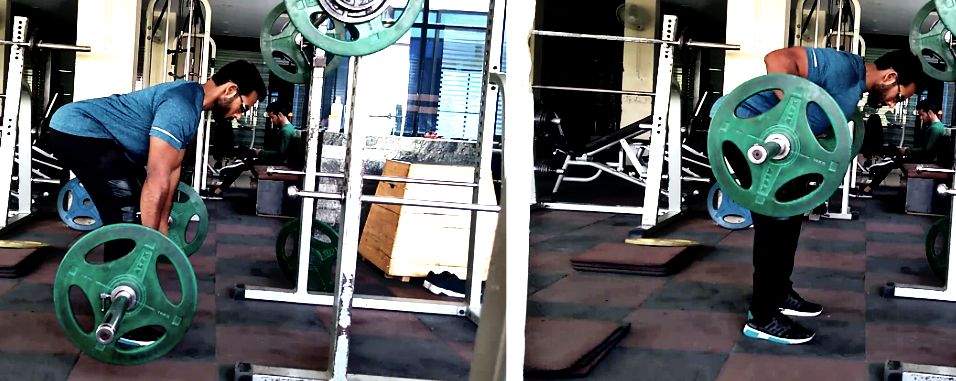
“Strong people are harder to kill than weak people and more useful in general.” – Mark Rippetoe
No one wants to appear weak or sissy.
A strong back is a symbol of strength and a sign of dominance. A strong back plays a key role in maintaining an upright posture – a sign of confidence.
Barbell bent over rows rank amongst the best exercises for building a strong back. This exercise has stood the test of time; it has been an integral part of back training programs for decades.
Top-level athletes and bodybuilders use this exercise to increase their back strength. But it’s not reserved for elites. Anyone and everyone will benefit from having a strong back and this exercise delivers it.
Table of Contents
What muscles do barbell bent over rows target?
Bent over rows involves all the major back muscles.
Prime target – Latissimus dorsi (or lats) – the largest upper body muscle.
Secondary muscles – Trapezius, Rhomboids, Teres major, Posterior deltoid, Teres minor and Infraspinatus of the Rotator cuff muscles, Erector spinae, Biceps, and Forearms.
How to do barbell bent over rows – A step-by-step breakdown
Proper setup
Step 1 – Stand in front of a loaded bar with a hip-width stance and toes pointing out 15 degrees.
Step 2 – Bend down by pushing your hips back and hold the bar with a double overhand grip (palm facing towards the body). Grip-width will be 3-4 inches wider than your shoulder-width.
Step 3 – Now, stand up with the bar.
Step 4 – In the standing position, lock your elbows and retract your shoulders to tighten the lats.
Step 5 – Keep your chest out and back in a neutral position.
Step 6 – Now bent over by pushing your hips back and unlocking your knees slightly.
Step 7 – Bend down till your upper body becomes parallel to the floor. In this position, the bar will come over your midfoot.
Step 8 – This is the starting position of the bent over rows.
How to execute
Step 9 – From the starting position, take a deep breath and pull the bar straight up.
Step 10 – The bar makes contact with your body around the upper abs region.
Step 11 – Lower the bar, in control, to the starting position.
Step 12 – Before starting the next rep, breath out and take a fresh breath. Maintain the shoulder and back position and repeat the movement.
Tips I use with my clients to improve their bent over rows:
1. Never start the movement from the bent position. Always stand up with the bar first. Then retract your shoulders and lock your back, before getting into the starting position.
2. Don’t keep the knees straight. Straight knees will stretch your hamstrings in a bent over position. To compensate this stretch, your lower back will become round.
3. Don’t bend the knees too much. This will hinder the bar from travelling straight up, as knees will come in the way.
4. Look at the floor 5-6 feet in front of you, to keep the neck in a neutral position. Do not look towards your feet. This will take the neck out of the neutral position.
5. Don’t try to pause at the top or try to intentionally slow down the descent of the bar.
6. Don’t let your shoulders drop. Maintain the shoulder position as the bar comes to the starting position.
7. Aim to hit the body with the bar as hard as possible. This cue will generate the maximum force to execute the movement.
Barbell bent over rows grip variations: Overhand or Underhand – Which one is better?
You can use an underhand grip (palm facing out). This grip will engage more of your biceps muscles.
The caveat, however, is that this grip can be irritating to the elbows, for people with inflexible forearm muscles. This grip demands complete supination of the forearms. Moving heavy weights with inflexible forearms is like asking for elbow injuries.
To check your forearm flexibility, hold the bar with an underarm grip and notice whether it feels comfortable to hold the bar in this position.
If you feel a tight stretch on your forearm muscles, this grip variation is not suitable for you.
7 Striking benefits of barbell bent over rows
1. Barbell bent over rows gives you a ‘V shape’ body
Bent over rows is a compound movement, working on all the back muscles. It allows you to lift challenging weights, which trigger the muscles to grow stronger and thicker.
The target muscle of this exercise is latissimus dorsi (or lats) – the muscle responsible for the aesthetic ‘V shape’. The lats connect five important points – spine, pelvis, ribs, scapula, and upper arms. Hence, strong lats act as a shield for your upper body.
Bent over row also targets the other major back muscles – rhomboid, trapezius, teres major, and poster deltoid.
This makes the bent over rows a complete package for training back muscles.
2. It helps you squeeze out 2-3 additional reps in pull-ups
Pull-ups, another important back exercise, target all the muscles mentioned above. But pull-ups are difficult for most beginners. They lack the strength needed to pull their body-weight.
This restriction is due to the lack of back strength. Bent over rows removes this roadblock by increasing your back strength.
3. It challenges your core muscles
The core muscles help in maintaining a neutral spine and a rigid torso while lifting weights in a bent over position. The challenge on the core increases as the weights get heavier.
4. It can raise your shoulder strength to new heights
Shoulder joints are the most unstable joints in your body. Deltoids and rotator cuff muscles keep these joints intact. Bent over rows strengthens the posterior deltoid (back of the shoulder) and teres minor and infraspinatus of the rotator cuff muscles. A strong and reliable base allows you to lift big weights.
When you are lifting anything overhead, posterior deltoid and rotator cuff muscles act as an anchor to keep the shoulder joints stable.
This added stability can help you increase the power of your shoulder press.
5. It gives you a strong posture that oozes confidence
Poor posture – a round shoulder and a round upper back, is a sign of a weak back. A strong back plays a vital role in maintaining a strong posture with a broad shoulder, straight back, chest up and neck held high.
The modern work life involves sitting long hours in front of a computer. And the spare time is spent sitting and staring at the smartphones.
Look at their posture. No wonder so many people are suffering from neck and back pain.
Bent over rows improves your back strength thereby improving your posture. And a good posture keeps away the neck and back pain.
6. It can help you hit new deadlift PRs
Bent over rows is a great assistant exercise for improving your deadlift.
The deadlift is hands down one of the best back exercises. It engages the muscles of your posterior chain like very few other exercises can match. Improving your deadlift enhances your entire musculature.
The deadlift requires a strong back, a neutral spine, and powerful hip extensors. Apart from strengthening your back, the bent over rows also works on your hip extensors – glutes and hamstrings. This gives you a carryover effect in improving your deadlift.
7. It gives you big biceps
During bent over rows, you pull the bar up by bending your elbows. This elbow bending is done by your biceps. The heavier the weights you are pulling, the greater the stress on your biceps. Thus, making them grow bigger.
And I can assure you that you can always pull more weights in the bent over rows than in any bicep exercise. This makes the bent over rows a mighty exercise for your biceps.
5 Lousy mistakes that are eating up your progress in Barbell bent over rows
1. Curving your back
A round back is a weak back. Rounding of back squeezes the spinal disk, exposing you to a risk of a back injury.
In the bent over position, you will be unable to maintain the tightness with a round back. Also, it will put the lats in a stretched position. The stretched lats will be incapable of producing a strong contraction needed for lifting heavy weights.
Fix – This problem occurs because of an improper form. To correct this, practice the movement with an empty bar and focus on keeping your back straight.
Over time, you will master the form and you can start adding the weights in an incremental manner. Ask a coach or an experienced training partner to check on your form.
2. Elbows flaring out at 90-degrees
In the bent over rows, the bar should move in a straight line over the midfoot.
When the bar makes contact around the upper ab region, your elbows will make a 75-degree angle with the body.
If your elbows flare out at 90-degrees, the bar will hit the body around the middle of the chest. This will take the bar out of the midfoot-line, affecting your stability. As the elbows flare out, the load will shift more from the lats to the posterior deltoid.
Fix- To keep the elbows at a proper angle you have to keep 2 things in mind.
1. Focus on keeping the bar-path in a straight line over the midfoot.
2. Be aware that the bar is hitting the body around the upper abdomen region.
3. Jerking your way down
The pulling of the bar should be forceful, but the lowering of the bar should not look like a free-fall.
If you let the gravity pull down the weights, the movement will stop with a jerk at the bottom. This will strain the shoulder joints.
Also, the jerk will lead to the rounding of the shoulders, making you lose the retracted shoulder position.
A round shoulder means loose lats. And the loose lats can never work at its highest capacity.
Fix – Lower the bar in control till your elbows lockout. No shoulder movement should occur after the elbows lock out. Consciously retract your shoulder blades before each rep.
4. Looking at yourself in the mirror while doing the movement
Looking up in the mirror while doing the bent over rows places the neck in hyperextension. This is an unsafe position for the neck as it compresses the disks between the cervical spine.
Fix- Look at the floor, 5-6 feet in front of you. This will keep the neck in a neutral position.
5. Your body going up and down rather than the barbell
This mistake happens when you try to add weights that are way beyond your capabilities. You know you will be unable to lift it with a proper form, but your big ego won’t let you cut back on the weights. So you cheat, by using the momentum rather than the muscle strength.
Instead of pulling the weights using your elbows, you raise your body to get the bar moving. And still, you are unable to bring the weights all the way up. Now, to make contact with the bar, you drop your body to meet the bar half-way.
This excessive movement won’t create the necessary stress on the back muscles, as the bar has travelled half-range. Dropping down your body takes the muscle’s work away from the hardest part of the movement.
Fix – To lift heavier weights, you are allowed to raise your body 15 to 20 degree above horizontal. This will engage the hip muscles to get the movement started.
But do not let your body drop down below parallel, to meet the bar. Cut back on the weights if this is happening.
Conclusion:
To get the most out of barbell bent over rows, you have to perform each rep with proper form. Always use weights that allow you to complete 8 to 10 reps in full range. Remember, if the bar is not hitting your body in every rep it is not a complete range.
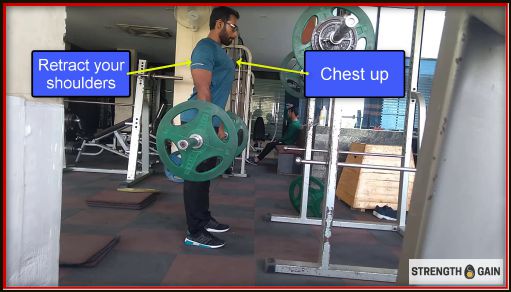
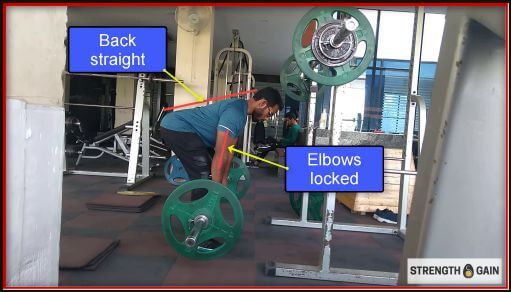
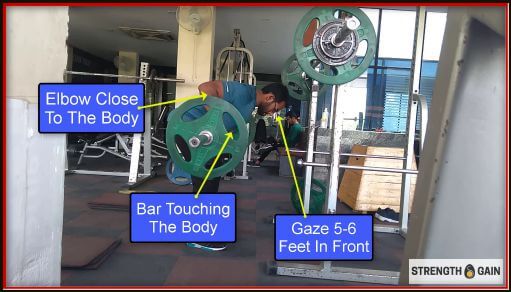
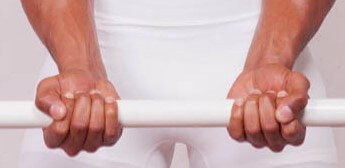

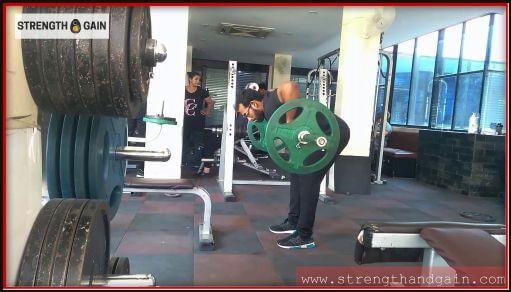
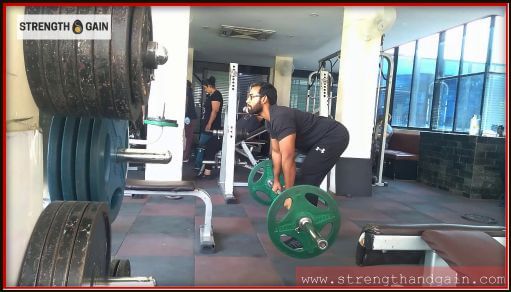
Leave a Reply